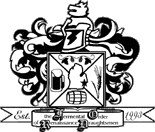 |
 |
 |
 |
 |
 |
| May 2001 | Fermental Order of Renaissance Draughtsmen | Vol. 9 No. 5 |
The next meeting will be held back at Sisko's in Taylor on Wednesday, May 23. Sisko's is located on Monroe (between Telegraph and Southfield), just south of Vanborn. Their address is 5855 Monroe and their phone number is 313-278-5340. Sisko's also has a website at http://www.siskos.com/. The competition for this May is porter. As usual, the thirsty hard-core who want dinner will start arriving around 5PM, people will drift in for an hour or so, and we will start our meeting around 6PM.
The winner of the Bock Competition are Bob and Kim Barrett. The score will be published in the next newsletter.
This May's competition will be the Porter Competition, Categories #15 a & b. The BJCP style guide follows.
15. PORTER
15A. Robust Porter
Aroma: Roast malt or grain aroma, often coffee-like or chocolate-like, should be evident. Hop aroma moderate to low. Fruity esters, and diacetyl, are moderate to none.
Appearance: Dark brown to black color, may be garnet-like. Clarity may be difficult to discern in such a dark beer. Head retention should be moderate to good.
Flavor: Malt flavor usually features coffee-like or chocolate-like roasty dryness. Overall flavor may finish from medium sweet to dry, depending on grist composition, hop bittering level, and attenuation. May have a sharp character from dark roasted grains. Hop flavor varies widely. Diacetyl moderate to none.
Mouthfeel: Medium to medium-full bodied. Low to moderate carbonation.
Overall Impression: A substantial dark ale with complex roasty malt, hop and fermentation characteristics.
History: Originating in England, Porter developed as a blend of beers or gyles known as "Entire." A precursor to stout. Said to have been favored by porters and other physical laborers.
Comments: Although a rather variable style, it may be distinguished from closely-related Stout as lacking the Stout’s roasted barley character.
Ingredients: May contain several malts, prominently dark roasted malts and grains, which often include black malt. Hops are used for bittering, flavor and/or aroma. Water must have significant carbonate hardness. Ale yeast is most common.
Vital Statistics: OG: 1.050- 1.065
IBUs: 25-45 FG: 1.012-1.016
SRM: 30+ ABV: 4.8-6.0%
Commercial Examples: Sierra Nevada Porter, Anchor Porter, Great Lakes Edmund Fitzgerald Porter.
15B. Brown Porter
Aroma: Malt aroma with mild roastiness should be evident. Hop aroma may be moderate to low. Esters and diacetyl may be moderate to none.
Appearance: Medium brown to dark brown in color. Clarity and head retention should be fair to good.
Flavor: Malt flavor will include mild to moderate roastiness. Hop flavor low to none. Hop bittering will vary the balance from slightly malty to slightly bitter. Diacetyl, and sourness or sharpness from dark grains, should be low to none.
Mouthfeel: Medium-light to medium bodied. Low to moderate carbonation.
Overall Impression: A fairly substantial dark ale with some roasty characteristics.
History: Originating in England, porter evolved from a blend of beers or gyles known as "Entire." A precursor to stout. Said to have been favored by porters and other physical laborers.
Comments: Softer flavors, lower gravities, and usually less alcohol than robust porter. More substance and roast than brown ale. Some versions are fermented with lager yeast. Balance tends toward malt more than hops.
Ingredients: May contain several malts, including dark roasted malts and grains. Hops are used chiefly for bitterness. Water should have significant carbonate hardness. Ale yeast, or occasionally lager yeast, is used.
Vital Statistics: OG: 1.040-1.050
IBUs: 20-30 FG: 1.008-1.014
SRM: 20-35 ABV: 3.8-5.2%
Commercial Examples: Samuel Smith Taddy Porter, Bateman Salem Porter, Shepherd Neame Original Porter, Yuengling Porter, Fuller's London Porter.
Here is the final count (chime in if I missed you...I missed myself the first go round). I believe the new total is 18 systems and 200 gallons even.
As I had mentioned prior to the BIG DAY, I was also drumming up support for the AHA via new memberships, renewals and extensions. Somehow, during the haze of the day I neglected my duties. I mentioned it to several people (Mike, Howard, Neil and others) and got positive reactions, but I never came forth with the forms and the information.
I have a couple of weeks yet to ask for people to consider (re)joining the AHA via Site #26 - The Barr House Brewery. I won't beg, whine or plead.. If you consider this a worthy organization, simply go to :
http://beertown.org/AHA/BIGBREW/index.htmDownload the form, fill out your check and either mail it to me at:
Chris Frey
275 S. Ann Arbor St.
Saline, Mi. 48176
or bring it to the next F.O.R.D. / AABG meeting.
Thank you for your support -

Editor's note: I am only going to include 12 pictures in the newsletter. In the online version, by clicking on this link, you will be able to see more Big Brew 2001 pictures.]
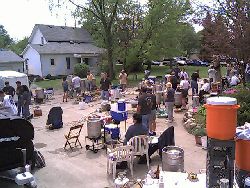 |
 |
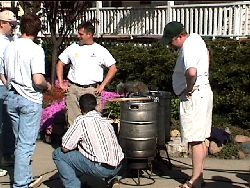 |
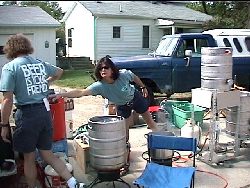 |
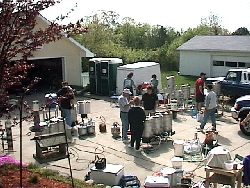 |
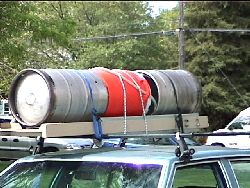 |
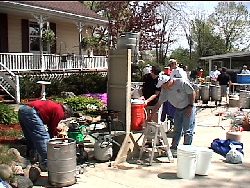 |
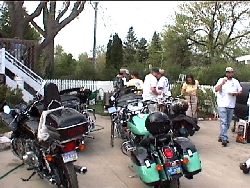 |
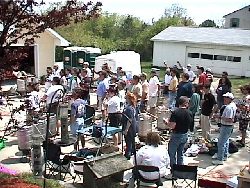 |
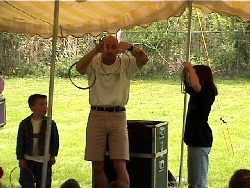 |
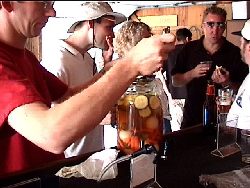 |
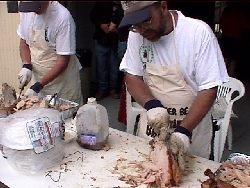 |
Well, as promised about a year ago, I have *finally* developed a system of email listservers to be rolled out to each "brewing region" - ostensibly, states and provinces.
The Alaska RBL has been running for about a week now, and most, if not all of the bugs seem to be infesting other software. Michigan's list is the second. You may subscribe to the Michigan RBL by sending
"subscribe michigan" for the email stream,
to rbl@hbd.org. If you'd like to have additional posting
addresses authorized, send "subscribe michigan-allowed
Thanks to all for their input on chest freezers for lagering!
A brief summary of gleanings, plus some note from private conversations with Forrest (FridgeGuy) Duddles:
Seals -- tight and durable
Locking Lid - keeps small children from suffocating, or from playing with
your beer ...
On Light - for the insecure
Casters - seems reasonable to me
Warranty -- Forrest says that all of the compressors come from only a very
few sources. Therefore, go for the best warranty
Size - 12.8 cubic foot minimum, da bigga da betta. Best to go out and
measure, and mock up a load to see what fits.
Controller - Ranco ECT111000 was Forrest's fave
Drain Plug - easier to hose out
Forrest also recommends sealing the seams with silicone sealant to prevent rusting. Some sort of plastic sheet "floor" would seem like a good idea to prevent scratches from moving carboys and kegs.
Sorry if I missed any points ...
Mark in Kalamazoo
> What's the verdict on the desirability of frost free?
Frost-free freezers tend to shorten the storage life of whatever is stored in them due to thermal cycling. A chest freezer in particular doesn't have anywhere near as great an air exchange rate as a typical fridge. In a brewing situation, or for long-term food storage, I'd consider frost-free to be a detriment.
With the temp controller holding at lagering temps (30-35degF? frost should not be an issue. The defrost cycle may throw temps off per Pat's experience. I don't know if any offer a defrost on/off switch (like the door seal heaters on some fridges). If, for some reason, you were to revert the function to holding frozen food (heresy!) you may wish you had it.
VINEYARD DINNER SERIES 2001 - MEET THE WINEMAKER
Sunday, June 3, 2001 at 6 p.m.
Colio Estates Winery, Harrow, Ontario
Largest of the "Boutique Wineries" in Canada
"Winery of the Year" at the 2000 Niagara Grape and Wine Festival
"VQA Excellence Award" and "Supplier of the Year" from Liquor Control Board Ontario; June, 2000
GOAT CHEESE, TOMATO AND TARRAGON BRUSCHETTA
CHICKEN LIVER PUREE ON FRENCH BREAD
SMOKED SALMON
RICOTTA CHEESE STUFFED CANNOLONI
IN A FRESH TOMATO BASIL SAUCE
BABY SPINACH SALAD WITH PEAR VINAGRETTE,
RED ONION, BLUE CHEESE AND TOASTED WALNUTS
VEAL SHANKS BRAISED IN WHITE WINE, ONION AND BEED BROTH
OVER YUKON GOLD GARLIC MASH
TIRAMISU WITH STRAWBERRY PORT WINE SAUCE
UPON ARRIVAL YOU WILL BE SERVED COLIO'S 'LILY CHAMPAGNE', THEN A TOUR OF THE WINERY BY WINEMAKER CARLO NEGRI. WAITER SERVED DINNER WILL BE PAIRED WITH 'ULTRA' PREMIUM RED OR WHITE VARIETAL WINES AND FINISH WITH RIESLING ICEWINE. DINNER WILL BE PRESENTED BY CHEF NICK POLITI, PROPRIETOR OF NICO?S RISTORANTE ON ERIE STREET IN WINDSOR'S LITTLE ITALY. NICK SERVED OUR LAST DINNER AND IT WAS SUPURB.
The complete price is $65 Canadian per person, or $50 US. There is no smoking. Mail a check to: JIM RICE, 24720 FAIRMOUNT DR., DEARBORN, MI. 48124. 313/277-3865
From the bridge, go south on Huron Church. It will curve and become Hwy 3; follow to Walker Road. Follow Leamington, not 401. Turn right (South) and travel through McGregor and into Harrow. Colio Drive is the first street on the left in Harrow.
From the tunnel, turn left and left again on Ouelette. Then left on Tecumseh (24 blocks) to Walker Road, turn right and follow the above directions. Approximate time: 30 minutes.
My third Vineyard dinner will be July 15. Please forward this to your friends.
This is from our May 1996 Newsletter. National Home Brew Day Festivities and Activities-Part One-Dearborn.
Report from Dearborn on National Homebrewers Day - Chris Frey
Saturday, May 4th, was National Home Brew Day and the club responded with a three-pronged strategy to demonstrate the various methods of home brewing at several of our favorite (and supportive!) home brew supply distributors. The club brewed in excess of seventy gallons and members taught each other many of the tricks of the trade. The public got the opportunity to witness how beer is made and asked F.O.R.D. members a variety of questions (the most popular of which was "when is it drinkable?").
In Dearborn at Merchants there were three brews done that day. Ted Geftus and Chris Frey co-led, with help from Tom Seija and Doug Geiss, the Pico all-grain effort that produced fourteen gallons of Tom's Rocket City Pale Ale. Gabrielle Palmer whipped up a 5 gallon batch of Nekkid Druids Nut Brown Ale using a combination of specialty grains, DME and lots of hops. Tyler Barber and Bill Cole sweated through their American Wheat brew and swear that they use more barley and less wheat in their next batch! A tip of the hat goes to Jim Bazzy for his organizational efforts in assuring that everything got to the site and for helping everyone out with their brews; to Tom Seija for lending his Pico system; to Bret Pastryk and his wife Gretchen and to Joe Brown for their support. Neal Petty, Thomas Plocher and Pat Babcock all brought their families to visit the brew site and Jerry Garner, Tim Tepatti, Joanne Wilson and Jerry Garner also stopped by to see how the day was going.
And special thanks go to Jonnah, Steve, Brian and the rest of the crew at Merchants for supporting the art of home brewing and their support of this days activities! And we all appreciated the wonderful Dijon and Parmesan Chicken breasts that Mark Polk of Academy Packing Co. provided and cooked and the awesome sausages that Steve and the crew grilled later in the day for us. Outstanding!
National Home Brew Day Festivities and Activities-Part Two-Royal Oak
Report from Royal Oak on National Home brewers Day
- Rich Byrnes
We met at sunrise for a hearty breakfast, well actually
more like 9am, 9:30 for some of us (no names mentioned), we met
at the Lantern restaurant, where a sign on the roof proudly proclaimed
"no cross table dancing allowed" and a sign over our
booth read "enjoy your food and get out" . At 10:00
sharp we started to unload our cars and start setting up, as I
put up the big red & white circus tent (OK, canopy) Doug Wood,
Mark Hansen, Joe Carulli, Mike Preston, Tom Herron, Scott Henry
and Aaron Dionne started unloading the 7 burners, 5 half barrels,
4 propane tanks, igloo cooler, 8 gallon Vollrath pot, and 5 gallon
stockpot that would make up the bulk of our equipment that day.
Mark & Doug were making an 11 gallon Strong Ale, Tom &
Mike were making a 15 gallon Pale Ale, Aaron was making a 5 gallon
cooler-mash Scotch Ale and Scott Henry was brewing a 5 gallon
extract Sierra Nevada Pale Ale clone. The grains were mostly donated
by Royal Oak Brewery (A special thanks to Wayne Burns & company
for donating the grains and great hats!) and Tony Randazzo &
Frank Retell made sure we had everything else we needed. The brewing
itself was flawless, a sight to behold! There were no equipment
or procedural snags, I got to test my re-circulation pump with
thermometer (it performed beautifully thank you very much!!).
The weather kept many people away, that was the only downside
to the entire day. In Royal Oak, when the weather is nice, people
go out! They walk, ride, roller blade and go places, with the
crappy cold damp weather, we had only about 50-60 people throughout
the day stop by. Toney did sell 3-4 starter kits I believe and
had a lot of positive feedback from the customers so that part
was a success. I believe to make this event a real success, more
advertising needs to be done in advance. Everyone that was there
brought home wort so that wasn't a problem, Wayne even donated
a 22 oz bottle of fresh yeast slurry for Doug & Marks batch.
Special thanks to everyone at Merchants Royal Oak (Tony/Frank/John
Joana), Royal Oak Brewery (Wayne & ?), everyone from the club
that came out and worked that day making beer, Pat Babcock, Neal
Petty, Tim Tepatti, Sandy Hill & George Dietrich for stopping
by to lend support and Jim Byrnes, my brother for lending me his
canopy. (Oh yeah, lets not forget Tammy Herron, Kim Babcock ,
Eileen Byrnes & all the future brewers & Brewsters who
showed up to root us on)
The styles for next month's competition are Weiss and Wit. Wit is an AHA club competition. The categories involved are 3b {American Wheat} , 17 a, b, c, & d {German Wheat Beers}, and 19 b {Wit}.
3B. American Wheat
Aroma: Characteristic of wheat with some graininess. Bavarian Weizen’s clovey and banana aromas are inappropriate. Hop aroma may be high or low but if present will be from American hop varieties.
Appearance: Usually pale straw to gold. Dark versions approximating Dunkel Weizens are acceptable. Clarity may range from brilliant to hazy with yeast approximating the hefe Weizen style of beer. Big, long-lasting head.
Flavor: Light graininess. Bavarian Weizenbier flavors such are banana esters and clove-like phenols are inappropriate. Hop flavor may be from low to high. Hop bitterness low to medium. Some fruitiness from ale fermentation acceptable; however, the use of a fairly neutral American ale yeast usually results in a clean fermentation. Little to no diacetyl.
Mouthfeel: Light to medium body. Higher carbonation is appropriate. Mouthfeel will appear lighter than actual body due to higher levels of carbonation.
Overall Impression: A light, refreshing beer that exhibits balanced hop and wheat maltiness.
Ingredients: Standard ale yeast. Often 50% wheat malt or more.
Vital Statistics: OG: 1.035-1.055
IBUs: 10-30 FG: 1.008-1.015
SRM: 2-8 ABV: 3.7-5.5%
Commercial Examples: Otter Creek Summer Wheat, Anchor Wheat, Boulevard Wheat, Pyramid Hefe-Weizen.
17. WHEAT BEER
17A. Bavarian Weizen
Aroma: Vanilla and clove-like phenols and fruity esters of banana are common. Hop aroma ranges from low to none. No diacetyl. Some aroma of wheat may be present.
Appearance: Pale straw to dark reddish-gold in color. A very thick, long-lasting head is characteristic. High protein content of wheat may impair clarity in an unfiltered beer, and clarity can be deliberately cloudy in a Hefe-Weizen from suspended yeast sediment. The filtered Krystal version is quite clear.
Flavor: The soft, grainy flavor of wheat is essential. Hop flavor is low to none and hop bitterness is very low. A tart character from yeast and high carbonation may be present. Spicy clove phenols and fruity esters, most prominently banana, are often present. No diacetyl.
Mouthfeel: The texture of wheat imparts the sensation of a fluffy, creamy fullness that may progress to a surprisingly light finish. A high carbonation level is typical.
Overall Impression: A pale, spicy, fruity, wheat-based ale.
History: A traditional wheat-based ale from Southern Germany that is a specialty for summer consumption.
Comments: These are refreshing, fast-maturing beers that are lightly hopped. The Hefe-Weizen version is served with yeast sediment stirred into it. The Krystal version is filtered for excellent clarity.
Ingredients: A high percentage of malted wheat is used which typically constitutes 50% or more of the grist, the remainder being pale barley malt. Weizen ale yeast produces the typical spicy and fruity essences during a relatively warm fermentation. Hops are used for a small amount of bittering only. Water character will vary.
Vital Statistics: OG: 1.040-1.056
IBUs: 10-20 FG: 1.010-1.014
SRM: 2-9 ABV: 4.3-5.6%
Commercial Examples: Paulaner Hefe-Weizen, Pschorr-Brau Weisse, Spaten Club-Weisse, Schneider Weisse, Julius Echter Weizenbier.
17B. Bavarian Dunkelweizen
Aroma: Gentle aroma of Munich malt supported by fruity, notably banana, and clove-spice aromas. No hop aroma. No diacetyl.
Appearance: Light amber to light brown in color. A thick, long-lasting head is characteristic. High protein content of wheat may impair clarity in an unfiltered beer.
Flavor: Melanoidins and caramel character of Munich and Vienna-type malts is prominent, along with some wheat flavor. There may be some spicy, fruity flavor as well. Roasty character is rare and very restrained if present. Low hop bitterness. No hop flavor. No diacetyl.
Mouthfeel: The texture of wheat imparts the sensation of a fluffy, creamy fullness that may progress to a lighter finish. However, the presence of Munich and Vienna-type malts provides its own sense of fullness. A moderate to high carbonation level is typical.
Overall Impression: A dark, malty, spicy, wheat-based ale.
History: A dark version of Bavarian Weizen.
Comments: The presence of Munich and Vienna-type barley malts gives this style a deeper and richer barley malt character than Bavarian Weizen. Often, there is less of the tart quality as well.
Ingredients: Wheat malt typically makes up 50% or more of the grist, the remainder being Munich or Vienna-type high-kilned barley malts. Some dark wheat malts may be used. Dark roasted malts are rarely used and then only in very small concentrations. Hops provide a mild bitterness only. Weizen ale yeast is used. Water character will vary.
Vital Statistics: OG: 1.040-1.056
IBUs: 10-20 FG: 1.010-1.014
SRM: 10-23 ABV: 4.3-5.6%
Commercial Examples: Pschorr-Brau Dunkel Weiss, Franziskaner Dunkel-Weizen, Schneider Dunkel Weiss.
17C. Berliner Weisse
Aroma: Slightly fruity; a sour aspect may be quite noticeable. On occasion a mild Brettanomyces yeast aroma may be present. No hop aroma. No diacetyl.
Appearance: Very pale straw in color. Clarity ranges from fair to cloudy. Despite high carbonation, head retention can vary from moussy to low.
Flavor: Lactic sourness dominates and can be quite strong, but some wheat flavor should be noticeable. Hop bitterness is very low. Mild Brettanomyces yeast character may be detected occasionally. No hop flavor. No diacetyl.
Mouthfeel: Light body. High carbonation.
Overall Impression: A very pale, sour, refreshing, low-alcohol wheat ale.
History: A regional specialty of Berlin; referred to by Napoleon's troops in 1809 as "the Champagne of the North" due to its lively and elegant character.
Comments: Often served with the addition of sugar syrups flavored with raspberry or woodruff to counter the substantial sourness. Has been described by some as the most purely refreshing beer in the world.
Ingredients: Wheat malt content is typically well under 50% of the grist, the remainder being pale barley malt. Lactobacillus delbruckii culture and fermentation provides the sharp sourness, which may be enhanced by blending of beers of different ages during fermentation and by extended cool aging. Ale yeast ferments to a low alcohol level. Hop bitterness is extremely low. Water may have significant hardness.
Vital Statistics: OG: 1.026-1.036
IBUs: 3-8 FG: 1.006-1.009
SRM: 2-4 ABV: 2.8-3.6%
Commercial Examples: Schultheiss Berliner Weisse, Berliner Kindl Weisse.
17D. Weizenbock
Aroma: A powerful aroma of ripe fruit is very common. Aroma of alcohol is also common. Some clove-spice aroma may be present. No hop aroma. No diacetyl.
Appearance: Light amber to dark brown in color. High alcohol level may impair what would otherwise be a thick, long-lasting head. Wheat protein content may impair clarity.
Flavor: Concentrated wheat flavor is dominant. Malty complexity, including smoky or raisin-like essences, may be present in darker versions. A fruity character is common, and some clove-spice flavor may occur. Well-aged examples may show some sherry-like oxidation as a point of complexity. Hop bitterness is well controlled to allow wheat and malt flavors to dominate the balance. No hop flavor. No diacetyl.
Mouthfeel: Full-bodied. A creamy sensation is typical, as is the warming sensation of substantial alcohol content. Moderate carbonation.
Overall Impression: A strong, malty, fruity, wheat-based ale.
History: A Bavarian specialty first introduced by Schneider in 1907 under the Aventinus name.
Comments: A Bock among Bavarian Weizen beers.
Ingredients: Wheat malt is typically 50% or more of the grist, the remainder barley malts. Hops provide mild bitterness only. Weizen ale yeasts are used. Water character can vary.
Vital Statistics: OG: 1.066-1.080+
IBUs: 15-30 FG: 1.015-1.022
SRM: 7-25 ABV: 6.5-8.0%+
Commercial Examples: Schneider Aventinus, Erdinger Pikantus, Pyramid Weizenbock.
19B. Witbier
Aroma: A sweet and occasionally honey-like character with prominent citrus (notably orange), herbal and spice aromas is characteristic, and is often followed by a mild phenolic aroma. Hop aroma is low to none. No diacetyl.
Appearance: Very pale straw to very light gold in color, and generally cloudy. Head retention should be quite good and of a moussy character.
Flavor: The flavor of unmalted wheat is typically noticeable. Coriander, citrus and mild phenolic flavors contribute to a complex and elegant character. A very slight lactic acidity resulting from a limited Lactobacillus fermentation is present in some examples, providing a refreshing quality, and is absent in others. Hop flavor is low to none. Hop bitterness is typically restrained, and some bitterness may also be contributed by bitter orange peel. No diacetyl.
Mouthfeel: Light to medium body. Effervescent character of high carbonation. Refreshing acidity.
Overall Impression: A refreshing, elegant, complex, wheat-based ale.
History: A 400-year-old beer style that died out in the 1950s, it was revived by Pierre Celis in the 1960s to steadily growing popularity thereafter.
Comments: The presence and degree of spicing and lactic sourness vary from one brand or brewery to another.
Ingredients: About 50% unmalted hard red winter wheat and 50% pale barley malt constitute the grist; in some versions a small percentage of raw oats is used as well. Spices of freshly-ground coriander and dried orange peel complement the sweet aroma and are quite characteristic; other spices may be used for complexity but are much less prominent. Ale yeast prone to production of mild, clovey/spicey flavors are very characteristic. In some instances a very limited Lactobacillus fermentation, or actual addition of lactic acid, is done.
Vital Statistics: OG: 1.042-1.055
IBUs: 15-22 FG: 1.008-1.012
SRM: 2-4 ABV: 4.2-5.5%
Commercial Examples: Celis White, Hoegaarden Wit, Steendonk Witbier, Brugs Tarwebier, Blanche de Bruges.
| Beer Events, Meetings & Competitions
Gabrielle Palmer |
 |
| Fermental Funny |
This editorial is copyrighted material, so I can only send the url. Enjoy it anyway.....
http://www.theonion.com/onion3717/beer_commercials.html| Ye Olde Brew News
published by the F.O.R.D. Homebrew Club |
|
| Editor:
Tony Tantillo Contributors:
Club Officers: |
F.O.R.D. is a private, non-profit organization of homebrewers. The main goal of this club is to promote awareness and appreciation of the quality and variety of beer; to share information regarding technique, equipment and skill required to brew quality homemade beer; and to encourage responsible use of beer as an alcohol-containing beverage. |